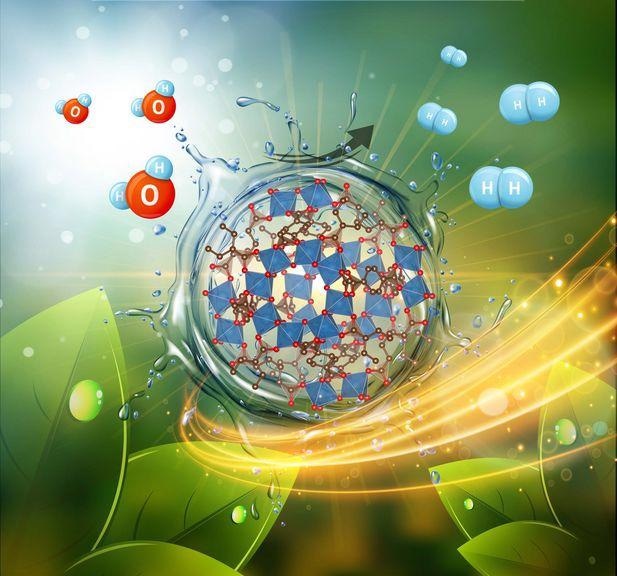Catalysts are normally solid materials whose surface comes into contact with liquids or gases, thus enabling certain chemical reactions.
 Artist’s impression of the catalytic process. Image Credit: Vienna University of Technology.
Artist’s impression of the catalytic process. Image Credit: Vienna University of Technology.
On the other hand, any atoms of the catalyst that are not on the surface serve no real purpose. As a result, it is vital to create extremely porous materials with as much surface area per gram of catalyst material as possible.
Scientists from TU Wien (Vienna) and other research groups have devised a novel approach for creating highly active sponge-like materials with nanometer-scale porosity. Metal-organic frameworks (MOFs), which already include numerous microscopic holes, were employed in a two-step method to produce the key breakthrough.
A new type of hole is later produced, which serves as a high-speed channel for molecules. This allowed previous activity records in the splitting of water into hydrogen and oxygen to be broken. The findings were published in the journal Nature Communications.
A Sponge on the Nanometer Scale
Metal-organic frameworks are an exciting class of multifunctional materials. They are composed of tiny metal-oxygen clusters that are linked with small organic molecules into highly porous hybrid networks. Outside we see a solid material, however, on the nanoscale it has a lot of open space that offers the largest known specific surface areas of up to 7000 m2 per gram.
Shaghayegh Naghdi, Study Lead Author, Vienna University of Technology
These characteristics commend MOFs for use in water purification, gas separation and storage and drug delivery. The atomic-scale proximity of molecular compounds with distinct electronic, chemical and optical properties makes them encouraging candidates for electro- and photo-catalysis.
A New Kind of Holes
Up until now, the biggest problem was that the diameter of the intrinsic pores is too small for an efficient catalytic turnover. We are talking about very long and extremely small pores of 0.5 to 1 nm in diameter, which is about the size of many small molecules. It takes some time for reactant molecules to reach the active sites inside the MOFs, which slows down the catalytic reaction considerably.
Dominik Eder, Professor, Vienna University of Technology
To get around this constraint, the researchers devised a strategy that makes use of MOFs’ structural flexibility.
We incorporated two structurally similar, but chemically different organic linkers to create mixed-ligand frameworks.
Dr Alexey Cherevan, Vienna University of Technology
“Due to the different thermal stability of the two ligands, we were able to remove one of the ligands in a very selective fashion through a process called thermolysis” states Shaghayegh Naghdi.
This allows for the installation of other types of pores with a diameter of up to 10 nm. The material’s initial nanopores are augmented by linked “fracture-type” holes that can serve as a high-speed connection for molecules moving through it.
Six Times as Reactive
The IMC team collaborated with colleagues from the University of Vienna and the Technion in Israel to comprehensively describe the novel materials, which were also evaluated for photocatalytic H2 development, using a variety of cutting-edge experimental and theoretical methodologies.
The addition of fracture-type holes might boost catalytic activity by six times, making these MOFs the greatest photocatalysts for hydrogen generation currently available.
Bigger holes are likely to have the greatest impact on liquid-phase applications, particularly those requiring the adsorption, storage and conversion of larger molecules, such as in medicine delivery and wastewater treatment.
This innovative technique offers additional advantages for photo/electrocatalytic applications. “The selective removal of ligands introduces unsaturated metal sites that can serve as additional catalytic reaction centers or adsorption sites. We expect that these sites will affect the reaction mechanism and thus the product selectivity of more complex catalytic processes,” explained Prof. Eder.
This theory is now being tested with MOFs for photocatalytic CO2 conversion into sustainable fuels and commodity chemicals. The chemical sector is also interested in these catalysts to help with the future replacement of energy-intensive thermal catalytic processes with more environmentally friendly photocatalytic processes at low temperatures and ambient settings.
The new approach is extremely adaptable, and it may be used on a wide range of MOF structures and applications. “Since we currently know of about 99.000 synthesized MOFs and MOF-type structures. There is actually a lot of work waiting for us in the future,” Shaghayegh Naghdi concluded.
Journal Reference:
Naghdi, S., et al. (2022) Selective ligand removal to improve accessibility of active sites in hierarchical MOFs for heterogeneous photocatalysis. Nature Communications. doi.org/10.1038/s41467-021-27775-7.